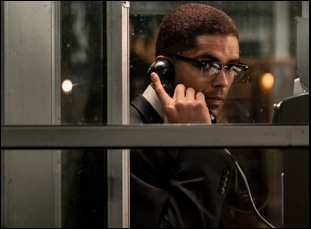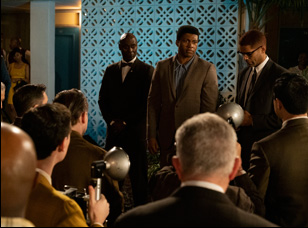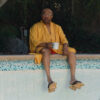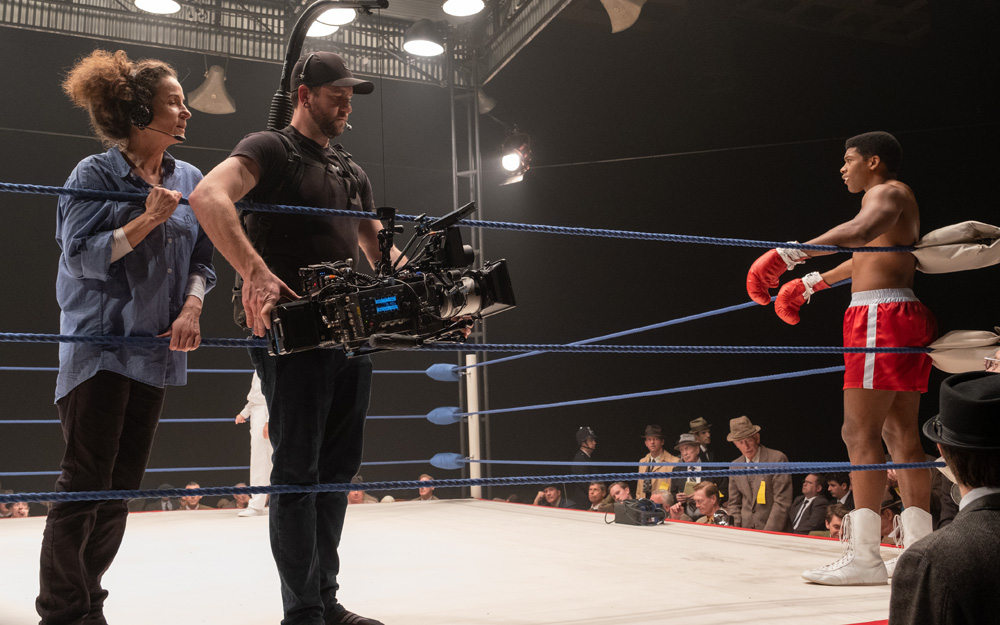“One Night in Miami” was born as a hypothetical when the writer Kemp Powers imagined what meeting might look like between a quartet of Black icons at a pivotal point for themselves and the civil rights movement. Bringing together Cassius Clay, Malcolm X, Sam Cooke and Jim Brown just after just after Clay’s career-defining victory over Sonny Liston to celebrate back in Clay’s hotel room, there was always such strong energy in the air when the drama was first performed as a play at the Rogue Machine Theatre in Los Angeles and when Regina King took an interest in making it her narrative feature directing debut, the actress’ experience of being on sets from the time she was 14 gave her both a good sense of how to translate that electricity to the screen and the need to bring on a crew behind the scenes that was every bit as towering in talent as those that would be front and center on screen.
It isn’t unexpected then that she would give a call to Tami Reiker, the cinematographer whose collaborations with Gina Prince-Bythewood (“Beyond the Lights,” “The Old Guard”) have become the stuff of legend, and has been able to allow a certain friction to emanate off the screen since starting out in the ‘90s indie film scene with films such as “The Incredibly True Story of Two Girls in Love” and “High Art.” “One Night in Miami” may open at a boxing match, vibrantly recreated in intricate detail by production designer Barry Robison and costume designer Francine Jamison-Tanchuck, but the fight that trails out of the ring as Clay, on the verge of changing his name to Muhammad Ali, Cooke, Brown and Malcolm X is captured as dynamically visually as Powers scripted it, considering what was the best way forward for these men of great cultural cache whose careers could be compromised if they spoke out more forcefully politically.
With passion dripping from the performances of Kingsley Ben-Adir, Eli Goree, Leslie Odom Jr. and Aldis Hodge as the central foursome, the drama requires a light touch where getting out of the way of its direct power is as impressive as any stylistic flourishes could be, but Reiker gently accentuates what unfolds before her lens with colors as vivid as the sharp words being used and a sense of geography in spaces that seem familiar but give way to uncharted territory for the men who are navigating such a complicated road ahead in their formative years. Greatness emerges naturally both from the men and the film itself and while it rarely strays from the setting of the Hampton House Hotel, the whole weight of the world can be felt within. As “One Night in Miami” makes its way out on Amazon Prime after taking the fall festival circuit by storm, Reiker spoke about capturing the intensity and intimacy of the lively drama and how her choice of camera brought an epic scope to a film with just a few locations and a short timeframe.

Working with Regina was incredible. She’s a powerhouse. She’s just so smart and dedicated and had such a clear vision of what she wanted, so collaborating with her was amazing. And also the material. The producers reached out to my agent and sent the script an I absolutely loved it after I read it. It’s so brilliant and powerful and I loved the time period. I’ve always been a huge fan of Muhammad Ali, so that was very exciting and when I went in and had a meeting with Regina, I brought her a look-book, and we discussed the way we thought it should be shot. And then I was off to New Orleans.
The film references several iconic photographs while making them your own. Was that interesting to work from?
Yeah, definitely. Like for the the Clay-Liston fight, we used the “GOAT [The Greatest of All Time]” book [by Jeff Koons]. That’s such an incredible book, and we really used that to be really authentic and recreate the same lighting grid that they had used for that fight. There was also the overhead shot that actually wasn’t from the Clay-Liston fight – it was from a later fight, but we loved that image so much, we recreated that. Then there was the shot in the pool of Cassius Clay [for the opening title scene], and then the diner, or Sam [Cooke] on Johnny Carson.

It was difficult in that it was really cold that day in New Orleans, and the steam was coming off the pool, and it was supposed to be Miami. [laughs] You really don’t see it in the scene, but it was like the one day where it was 40 degrees all of a sudden. It was tricky to find a pool that was deep enough yet had a beautiful surface inside the pool. There were a lot that had tiles or they were just the wrong feeling, but that one worked out well for us.
Was the Miami setting exciting when I imagine that you could draw on a broad color palette?
Yes, it was. When I went into meet with [Regina], I really presented this idea of a really [high] contrast, saturated film, something that I hadn’t done in a while, and that I missed. It was the same vision that she had, these really vibrant blues and neon from Miami in contrast to the warmth of the hotel, and Regina and Barry [Robison], the production designer, and I, and Francine [Jamison-Tanchuck], the costume designer, we all worked really closely together designing the color palette. Francine made those incredible sharkskin suits. We were always comparing [each other’s work] with what the lighting was going to be — the fabric, the bedspread, the suit, how it was all going to blend together and shooting tests of that. Then designing the room, Regina really wanted it to always start with what was actually authentic, [though] we made it a little bit bigger because it was a lot to do in there.
What was it like making that space so dynamic?
The actual interior of the room, we built on the stage. Then Barry found a really cool hotel an hour-and-a-half from New Orleans that was sort of rundown, but it was the same bones as the Hampton House, with the pool in the middle and the lobby, so he recreated the Hampton House there. That’s where we did all of the hallways and the drive-ups and the exterior of the diner and the telephone booth. And we had that inside/outside that we had to keep. We wanted to have them come do as much as we could outside, because it was a breath of fresh air from being in the hotel room.

Regina and I absolutely didn’t want to do it on blue screen. We wanted to do it on a rooftop, but when we were scouting rooftops, the actors would have had to be on wires because it was too dangerous. None of them had a [long] lip, a edge. They just had like a little two-foot lip, and it was too dangerous. This was the scene where they’re moving around and talking to the camera, so Barry came up with an idea of building the roof on shipping containers, right outside the stage. Our stages were far from New Orleans, so we were able to do it at night, and we put a little black railing up there, that just disappeared because we had 280 degrees of just darkness and they had the freedom to move around.
In terms of lighting this, was that something that you were generally conscious of — giving the space for the actors to create their own movement?
Yeah, definitely, both in the hotel and on the roof. We wanted to give them the space to move around. And the hotel room, both cameras were on jib-arms that were manually operated by the operator so that they could drift with them. We had those jib-arms poking through every door and window. And wherever there was a painting or a mirror, there was a hole behind it that we could pop that off and shoot through there. We wanted to keep changing the perspective so that the camera could float from character to character, and then when they’re up on the roof, because they busted out of the room for a second, that was handheld so that we could then walk or pan from character to character, but giving them the freedom to move in that space. We shot very long takes, like 10, 12-minute takes, because the scenes were that long.

She’s an actor’s director, so she knew what they would want, and the scenes, especially in the hotel room, were so intense and so powerful. You couldn’t really just say to an actor, “We’re going to cut halfway through and then pick it up again.” Especially Kingsley [Ben-Adir], who plays Malcolm X, she really liked to ramp up into it. But we found there were so many beautiful discoveries by doing the entire scene take after tak,. It gave us more opportunity to drift from character to character, find a reflection in the mirror and those type of things.
That’s interesting because I would’ve suspected that mirror dead in center in the room might’ve been tricky to navigate around without the camera getting in the shot.
It created a lot of opportunities because at a certain point, you’ve been in that room so much. You’re like, “Okay, what haven’t we used? What can we do?” And that’s where that scene came about with Cassius and Jim Brown where they’re both looking in the mirror, talking, and it’s going back and forth between the reflections and the person.

We definitely discussed that. We chose to shoot large format in 2.39 aspect ratio, and we kept it fairly wide. It’s one of the things I love about the movie. It feels like an older movie because it’s not all super-tight closeups. You have that aspect ratio, and you have these four men, so there’s always someone lingering on the edge of frame, or you’re shooting over someone’s shoulder.
Is it true the decision to shoot in large format was influenced by your work on “The Old Guard”? That seems counter-intuitive given the scale of the story, but it works perfectly.
Yes. That film [“The Old Guard”] had of a lot of very tight shots, but I really loved that camera, and I loved the large format and the drop-off you get with the lenses. It creates such an immersive experience. I remember when I went to see “Joker” in the theater, and that was the Alexis 65 sand the prime DNAs. And I just felt like I could reach out and touch it. With Alexa 65, you really have three, maybe four choices if you want to shoot the Hawks, but they’re a little different, so you have three, and these Prime DNAs were the fastest and also the softest around the edges. They’re still very sharp, but we use a Number One Bronze Glimmerglass to take just the video edge off. It just felt so visceral, and that’s what I wanted for this film. These four characters, these iconic characters, you really wanted to feel them.
“One Night in Miami” is now streaming on Amazon Prime.




